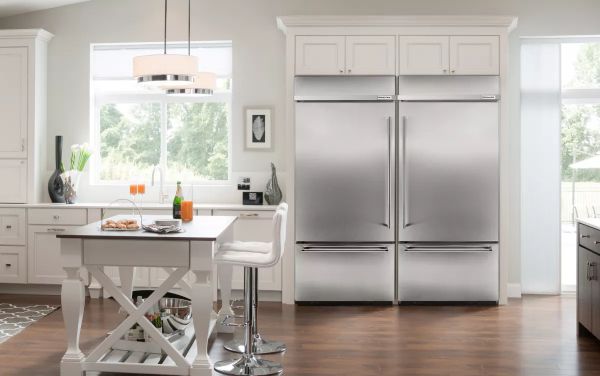When it comes to selecting a refrigerator for your kitchen, you have the option of choosing between a built-in refrigerator and a freestanding refrigerator. Both types offer distinct advantages and considerations.
In this blog post, we will compare built-in and freestanding refrigerators, providing you with essential information to help you make an informed decision based on your specific needs and kitchen layout.
Table of Contents
Design and Integration
One of the primary differences between built-in and freestanding refrigerators lies in their design and integration into your kitchen:
Built-in refrigerators are designed to seamlessly blend into your kitchen cabinetry. They offer a custom, sleek look as they are installed flush with the surrounding cabinetry and have panels that match the kitchen design. Built-in refrigerators provide a seamless, integrated appearance, enhancing the overall aesthetics of your kitchen.
Freestanding refrigerators are standalone units that can be placed anywhere in your kitchen as long as there is sufficient space. They have finished sides and backs, so they don’t require any specific integration with cabinetry. Freestanding refrigerators come in various sizes, styles, and finishes, providing flexibility in terms of placement and design options.
Size and Layout Considerations
The size and layout of your kitchen play a significant role in determining whether a built-in or freestanding refrigerator is more suitable:
Built-in refrigerators are available in standard widths to fit seamlessly with your kitchen cabinetry. They are generally taller and wider than freestanding models, offering ample storage space. However, built-in refrigerators require precise measurements and custom installation, making them more suitable for kitchen remodels or new constructions where cabinet space can be designed accordingly.
Freestanding refrigerators come in a range of sizes, from compact models to full-sized options. They are more flexible in terms of placement since they don’t require specific cabinet space. Freestanding refrigerators are suitable for kitchens with limited space or for homeowners who prefer the option to relocate the refrigerator in the future.
Cost and Flexibility
Consider the cost and flexibility factors when comparing built-in and freestanding refrigerators:
Built-in refrigerators generally have a higher upfront cost compared to freestanding models. They often require professional installation and custom paneling, adding to the overall expense. However, built-in refrigerators offer a luxurious and customized look that can add value to your kitchen and home.
Freestanding refrigerators are generally more affordable and readily available compared to built-in models. They offer flexibility in terms of placement and can be easily moved if needed. This makes them a suitable option for renters or homeowners who may want to change the kitchen layout in the future.
Features and Technology
Both built-in and freestanding refrigerators offer a wide range of features and technologies to enhance convenience and performance:
Built-in models often come equipped with advanced features such as dual cooling systems, precise temperature control, humidity-controlled drawers, and customizable storage options. They may also offer smart technology integration, touch-screen displays, and Wi-Fi connectivity for added convenience.
Freestanding refrigerators also offer a variety of features, including adjustable shelves, ice and water dispensers, temperature control options, and energy-efficient settings. Many models come with smart features, such as app control and voice commands, providing convenience and connectivity.
Maintenance and Repairs
Consider the maintenance and repair aspects when choosing between a built-in and freestanding refrigerator:
Built-in refrigerators may require specialized maintenance and repairs due to their integrated design. If any issues arise, it is recommended to consult a professional technician with expertise in built-in refrigerator repairs. Keep in mind that accessing certain components for repairs or maintenance may require removing surrounding cabinetry.
Freestanding refrigerators are generally easier to maintain and repair. They can be serviced by most appliance technicians without the need for specialized knowledge or tools. Additionally, if you need to replace or upgrade your refrigerator in the future, it is simpler and more cost-effective to do so with a freestanding model.
Built-In Refrigerator vs. Freestanding
| Comparison | Built-In Refrigerators | Freestanding Refrigerators |
|---|---|---|
| Design | Integrated with cabinetry, seamless look | Standalone unit, finished sides and back |
| Size and Layout | Taller and wider, requires custom installation | Available in various sizes, flexible placement |
| Cost | Higher upfront cost, custom installation | Generally more affordable |
| Flexibility | Not easily movable, fixed in place | Easily movable, flexible placement |
| Features and Technology | Advanced features, smart technology integration | Wide range of features, smart features available |
| Maintenance and Repairs | May require specialized maintenance and repairs | Easier to maintain and repair |
Conclusion
Choosing between a built-in refrigerator and a freestanding refrigerator ultimately depends on your kitchen design, budget, space availability, and personal preferences. Built-in refrigerators offer a seamless, integrated look that enhances the overall aesthetics of your kitchen but require precise measurements, custom installation, and a higher upfront cost. On the other hand, freestanding refrigerators provide flexibility in placement, come in various sizes and styles, and are generally more affordable.
Consider the size and layout of your kitchen, the desired level of integration, available budget, and the specific features and technologies you seek in a refrigerator. Assess the long-term benefits, such as added home value and customization, as well as the maintenance and repair considerations associated with each option.
Ultimately, by evaluating your needs and weighing the pros and cons of built-in and freestanding refrigerators, you can make an informed decision that aligns with your kitchen requirements and personal preferences. Remember to compare models, read customer reviews, and consult with appliance professionals to ensure you select the refrigerator that best suits your needs and enhances your kitchen experience.

